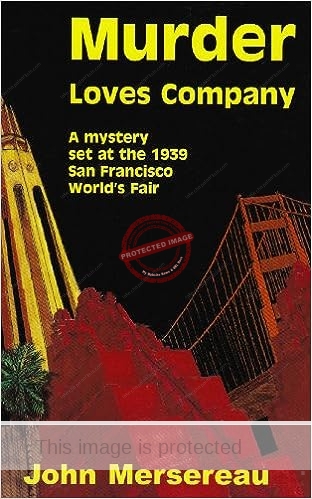When novelist John Mersereau retired in about 1960, he and his wife, Margaret, set off for Mexico, where they fell in love with the country and bought a house in Ajijic. The house, at Zaragoza #9, had formerly been owned by self-styled artist Dotty Strang. Strang had given free art classes to some local children, even though one of her local friends, contractor Marcos Guzmán, had advised that she charge something, however small, for the classes so that the children would value them.

The Mersereaus’ circle of friends in Ajijic included Dick and Nina Ketmer Bishop, Bill Atkinson; writer Gina Dessart Hildreth and her husband, Phillip; writer Bob Somerlott; real estate developer Lou Wertheimer and his wife, Cathy; and Helen Kirtland, the founder of Ajijic Hand Looms, and her husband, Larry Hartmus. The men, and Gina Hildreth formed an Ajijic chess club which held multi-week competitions.
Dick Bishop was one of Ajijic’s more colorful characters in the 1960s and 1970s, and forever associated with riding his large Arabian horse through the village. When the Mersereaus commissioned local contractor Marcos Guzmán to build them a house west of Ajijic at Rancho Nuevo, Nina Ketmer Bishop sculpted for them, as a gift, an equestrian statue of Margaret Mersereau, because Margaret also loved charro and rode her young Arab thoroughbred filly in all the village parades.
John Joshua Mersereau was born in Manistique, Michigan, on 23 January 1898. The family moved, while he was still a youngster, to Oakland, California, where John graduated from Oakland High School before studying, on and off, at the University of California. His college friends included Robert (‘Bobby’) Hyde, the author of Crude. Mersereau married Winona (‘Margaret’) Roberts and the couple had two sons: Charles, and John, Jr.
When the U.S. entered the second world war, Mersereau, then 43, enlisted in the Navy and was commissioned a lieutenant, serving as a speechwriter for the Twelfth Naval District. He completed his service after the war as a co-editor of a navy recruitment magazine.
Prior to retirement, the Mersereaus made their family home in Santa Barbara, California.
While none of Mersereau’s works were written, or set, in Mexico, his novel Murder Loves Company (1940) is a mystery story set at the 1939-1940 San Francisco World’s Fair. This Fair has numerous connections to Lake Chapala and his book is an interesting portrait of life in California at the end of the 1930s.
In addition to Murder Loves Company, Mersereau’s other published works include The Checkered Flag (1925), The Whispering Canyon (1926)—both of which were bought for movies—Gill O’ the Rangers (1930) and The Corpse Comes Ashore (1941). Mersereau also wrote a number of pulp magazine stories under the pseudonym Richard Race Wallace.
By coincidence, Mersereau’s story “Off the westbound freight” was published in 1934 in the same issue of Cowboy stories as a submission by ‘Bruce Douglas’— the pen name of Theodore Wayland Douglas (1897-1961)— who also later lived for a time in Ajijic.
After moving to Ajijic, the Mersereaus were visited by Kenneth Millar, a fellow mystery writer and friend from Santa Barbara. Millar (better known by his pen name Ross Macdonald) later used Ajijic as a setting for several chapters in his novel The Zebra-Striped Hearse (1962).
In the mid-1960s, the Mersereaus contracted Marcos Guzmán to build them a house west of the village at Los Charales, where they lived until 1972. They spent the remainder of their lives in Forsythe, Missouri, where John died in February 1989 and Winona (‘Margaret’) in January 1994.
Acknowledgments
This profile could not have been written without the assistance of the late John Mersereau Jr., who shared memories of his father’s time in Ajijic with me in 2008. The article by Tom & Enid Schantz on the now defunct website of the Rue Morgue Press was also helpful.
Several chapters of Foreign Footprints in Ajijic: Decades of Change in a Mexican Village offer more details about the history of the artistic community in Ajijic. Chapter 20 is about Helen Kirtland, and chapter 37 is about Dick Bishop’s long association with the village.
Sources
- Tom & Enid Schantz. 2004. “John Mersereau.” Online (2004 to Jan 2025) at http://www.ruemorguepress.com/authors/mersereau.html
- Santa Barbara News-Press: 11 Jan 1961, 11.
- Guadalajara Reporter: 30 April 1964; 10 Dec 1964.
- John Mersereau. 1934. “Off the westbound freight.” Cowboy stories (Vol. 26, no. 3).
- John Mersereau. 1940. Murder Loves Company. Philadelphia & New York: J.B. Lippincott Company.
Comments, corrections and additional material are welcome, whether via the comments feature or email.
Tony Burton’s books include “Lake Chapala: A Postcard History” (2022), “Foreign Footprints in Ajijic” (2022), “If Walls Could Talk: Chapala’s historic buildings and their former occupants” (2020), (available in translation as “Si Las Paredes Hablaran”), “Mexican Kaleidoscope” (2016), and “Lake Chapala Through the Ages” (2008).
Thanks–the lake certainly did draw interesting people over the centuries –